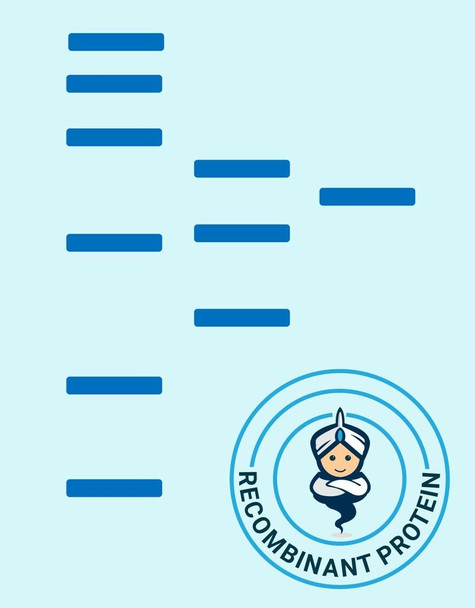Description
| Product Name: | Human BIN1 Recombinant Protein |
| Product Code: | RPPB5855 |
| Size: | 20µg |
| Species: | Human |
| Target: | BIN1 |
| Synonyms: | AMPH2, AMPHL, MGC10367, SH3P9, Amphiphysin II. |
| Source: | Escherichia Coli |
| Physical Appearance: | Sterile filtered colorless solution. |
| Formulation: | BIN1 protein solution (1mg/ml) containing 20mM Tris buffer pH-8, 1mM DTT & 10% glycerol. |
| Stability: | Store at 4°C if entire vial will be used within 2-4 weeks. Store, frozen at -20°C for longer periods of time. For long term storage it is recommended to add a carrier protein (0.1% HSA or BSA).Avoid multiple freeze-thaw cycles. |
| Purity: | Greater than 90.0% as determined by SDS-PAGE. |
| Amino Acid Sequence: | MGSSHHHHHH SSGLVPRGSH MAEMGSKGVT AGKIASNVQK KLTRAQEKVL QKLGKADETK DEQFEQCVQN FNKQLTEGTR LQKDLRTYLA SVKAMHEASK KLNECLQEVY EPDWPGRDEA NKIAENNDLL WMDYHQKLVD QALLTMDTYL GQFPDIKSRI AKRGRKLVDY DSARHHYESL QTAKKKDEAK IAKAEEELIK AQKVFEEMNV DLQEELPSLW NSRVGFYVNT FQSIAGLEEN FHKEMSKLNQ NLNDVLVGLE KQHGSNTFTV KAQPSDNAPA KGNKSPSPPD GSPAATPEIR VNHEPEPAGG ATPGATLPKS PSQPAEASEV AGGTQPAAGA QEPGETAASE AASSSLPAVV VETFPATVNG TVEGGSGAGR LDLPPGFMFK VQAQHDYTAT DTDELQLRAG DVVLVIPFQN PEEQDEGWLM GVKESDWNQH KELEKCRGVF PENFTERVP |
BIN1 is a nucleocytoplasmic adaptor protein, one of which was primarily identified as MYC-interacting protein having the characteristics of a tumor suppressor. BIN1 protein interacts with and inhibits the oncogenic activity of the myc oncoprotein that is a key player in many human cancers. The absence of Bin1 contributes to growth deregulation in cancer cells in carcinoma of the breast, colon, lung, cervix, prostate and liver.
BIN1 Recombinant Human produced in E.Coli is a single, non-glycosylated polypeptide chain containing 459 amino acids (1-439 a.a) and having a molecular mass of 50.4 kDa. The BIN1 is fused to a 20 amino acid His-Tag at N-terminus and purified by proprietary chromatographic techniques.
| UniProt Protein Function: | BIN1: May be involved in regulation of synaptic vesicle endocytosis. May act as a tumor suppressor and inhibits malignant cell transformation. Defects in BIN1 are the cause of centronuclear myopathy type 2 (CNM2). A congenital muscle disorder characterized by progressive muscular weakness and wasting involving mainly limb girdle, trunk, and neck muscles. It may also affect distal muscles. Weakness may be present during childhood or adolescence or may not become evident until the third decade of life. Ptosis is a frequent clinical feature. The most prominent histopathologic features include high frequency of centrally located nuclei in muscle fibers not secondary to regeneration, radial arrangement of sarcoplasmic strands around the central nuclei, and predominance and hypotrophy of type 1 fibers. 11 isoforms of the human protein are produced by alternative splicing. |
| UniProt Protein Details: | Protein type:Tumor suppressor; Cytoskeletal; Adaptor/scaffold; Vesicle Chromosomal Location of Human Ortholog: 2q14 Cellular Component: I band; synaptic vesicle; membrane; axon; T-tubule; cytoplasm; nerve terminal; Z disc; nucleus; actin cytoskeleton Molecular Function:identical protein binding; protein binding; GTPase binding; protein heterodimerization activity; protein complex binding; tau protein binding Biological Process: cell proliferation; muscle cell differentiation; viral reproduction; regulation of neuron differentiation; positive regulation of apoptosis; positive regulation of endocytosis; endocytosis; positive regulation of GTPase activity; positive regulation of astrocyte differentiation Disease: Myopathy, Centronuclear, 2 |
| NCBI Summary: | This gene encodes several isoforms of a nucleocytoplasmic adaptor protein, one of which was initially identified as a MYC-interacting protein with features of a tumor suppressor. Isoforms that are expressed in the central nervous system may be involved in synaptic vesicle endocytosis and may interact with dynamin, synaptojanin, endophilin, and clathrin. Isoforms that are expressed in muscle and ubiquitously expressed isoforms localize to the cytoplasm and nucleus and activate a caspase-independent apoptotic process. Studies in mouse suggest that this gene plays an important role in cardiac muscle development. Alternate splicing of the gene results in ten transcript variants encoding different isoforms. Aberrant splice variants expressed in tumor cell lines have also been described. [provided by RefSeq, Sep 2011] |
| UniProt Code: | O00499 |
| NCBI GenInfo Identifier: | 14916535 |
| NCBI Gene ID: | 274 |
| NCBI Accession: | O00499.1 |
| UniProt Secondary Accession: | O00499,O00297, O00545, O43867, O60552, O60553, O60554 O60555, O75514, O75515, O75516, O75517, |
| UniProt Related Accession: | O00499 |
| Molecular Weight: | 593 |
| NCBI Full Name: | Myc box-dependent-interacting protein 1 |
| NCBI Synonym Full Names: | bridging integrator 1 |
| NCBI Official Symbol: | BIN1�� |
| NCBI Official Synonym Symbols: | AMPH2; AMPHL; SH3P9�� |
| NCBI Protein Information: | myc box-dependent-interacting protein 1; amphiphysin II; amphiphysin-like protein; box dependant MYC interacting protein 1; box-dependent myc-interacting protein 1 |
| UniProt Protein Name: | Myc box-dependent-interacting protein 1 |
| UniProt Synonym Protein Names: | Amphiphysin II; Amphiphysin-like protein; Box-dependent myc-interacting protein 1; Bridging integrator 1 |
| Protein Family: | Myc box-dependent-interacting protein |
| UniProt Gene Name: | BIN1�� |
| UniProt Entry Name: | BIN1_HUMAN |






